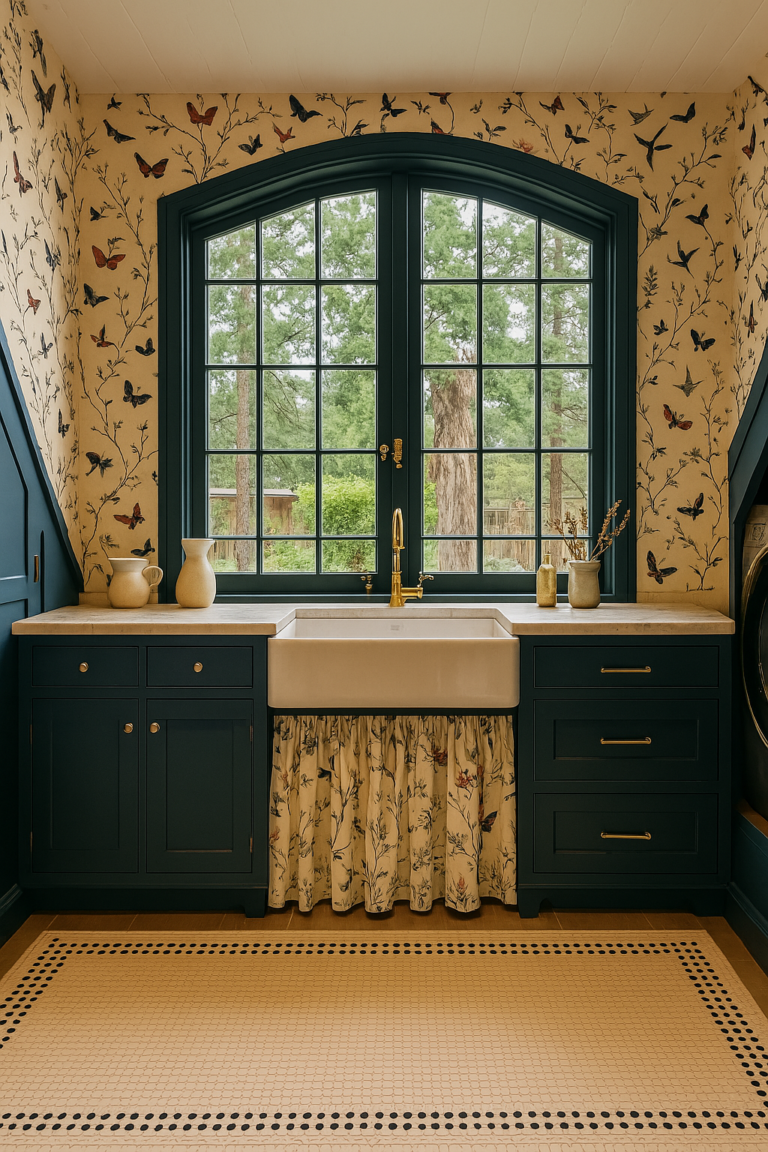12 Gorgeous Japanese Courtyard Garden Ideas That Feel So Zen
I’ve often daydreamed about having that peaceful oasis right outside my own door, a little slice of Zen just steps away. Guess what? Even a compact courtyard or small backyard can become that tranquil escape! Let’s dive into the beautiful world of Japanese courtyard gardens together and explore how you can bring that unique serenity and aesthetic into your own space.
Find Your Zen: 12 Inspiring Japanese Courtyard Garden Design Ideas
1. Illuminate the Night: Magical Garden Lighting
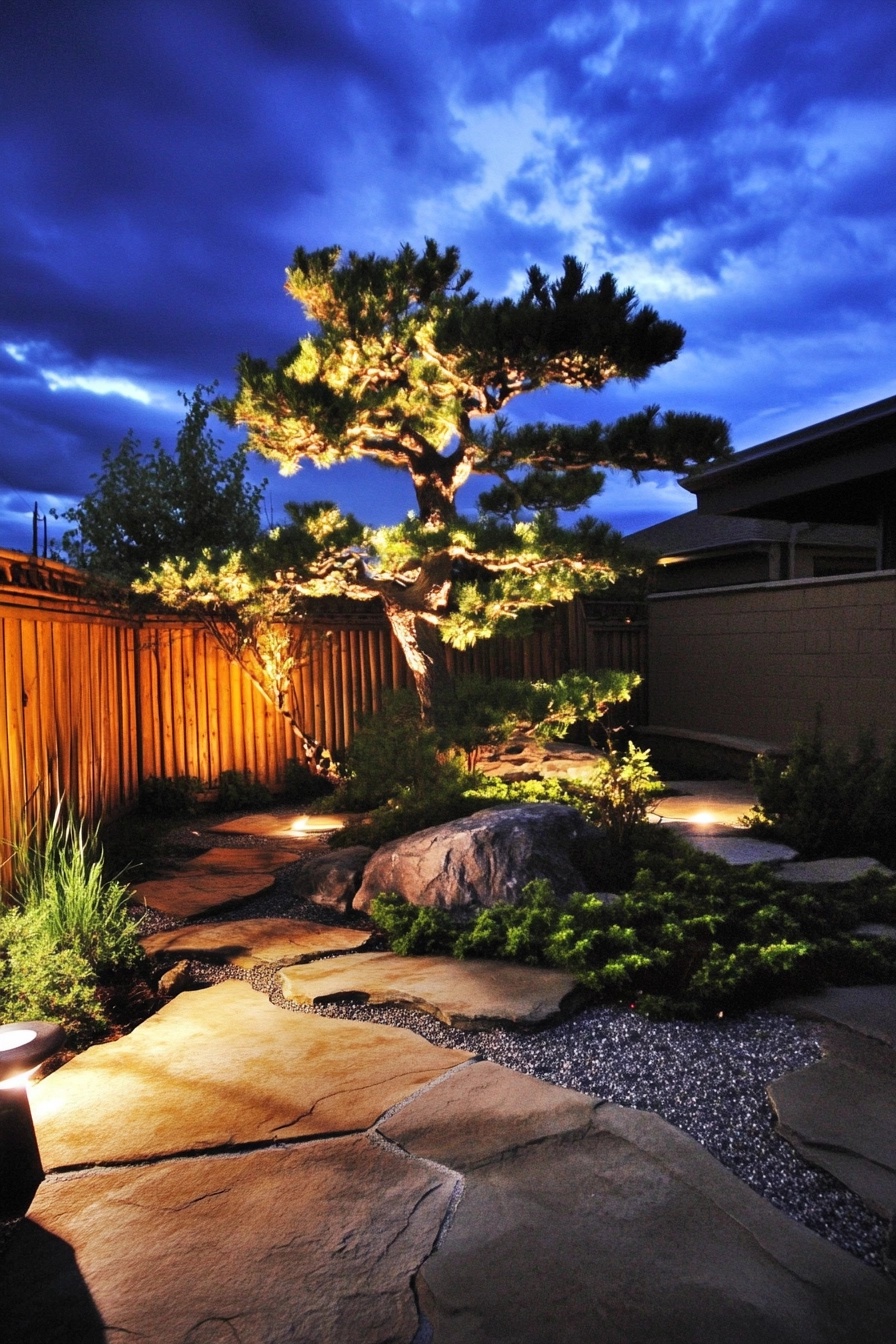
Strategic lighting transforms this Japanese courtyard after dark. Uplighting on the sculpted pine tree and low lights along the path create depth, drama, and allow enjoyment well into the evening. It highlights the textures of the stone and plants beautifully.
Don’t let sunset be the end of enjoying your beautiful Japanese garden! Thoughtful lighting can completely transform the space, creating a truly magical and serene atmosphere. Think about using subtle uplighting to highlight the sculptural form of a feature tree, like this gorgeous pine. Low-level path lighting isn’t just practical for safety; it can also draw the eye along the curves of your stepping stones, making the garden feel inviting even after dark. Consider using warm-toned bulbs to maintain that peaceful, natural feeling. It’s amazing how a few well-placed lights can enhance the textures of rocks, gravel, and foliage, adding a whole new dimension to your Japanese backyard ideas.
2. Perfectly Peaceful Small Japanese Garden Ideas

This image proves you don’t need vast acreage for a stunning Japanese garden. Careful placement of elements like the stepping stone path through gravel, vertical interest from the birch and bamboo, and the focal point Japanese maple creates a full, serene scene in a limited area.
Got a small courtyard or patio? You can absolutely create your own slice of Japanese garden paradise! The key is often about careful selection and placement, making every element count. Look how this space uses a simple gravel path with neat stepping stones to create movement and visual flow. Incorporating vertical elements like the slender birch tree and bamboo fencing draws the eye upward, making the space feel taller. And, of course, a beautiful Japanese maple adds that essential touch of color and delicate form. Don’t overcrowd it – sometimes less really is more when aiming for that peaceful Japanese garden aesthetic, especially when working with small Japanese garden ideas.
3. Modern Japanese Garden Design for Sleek Spaces
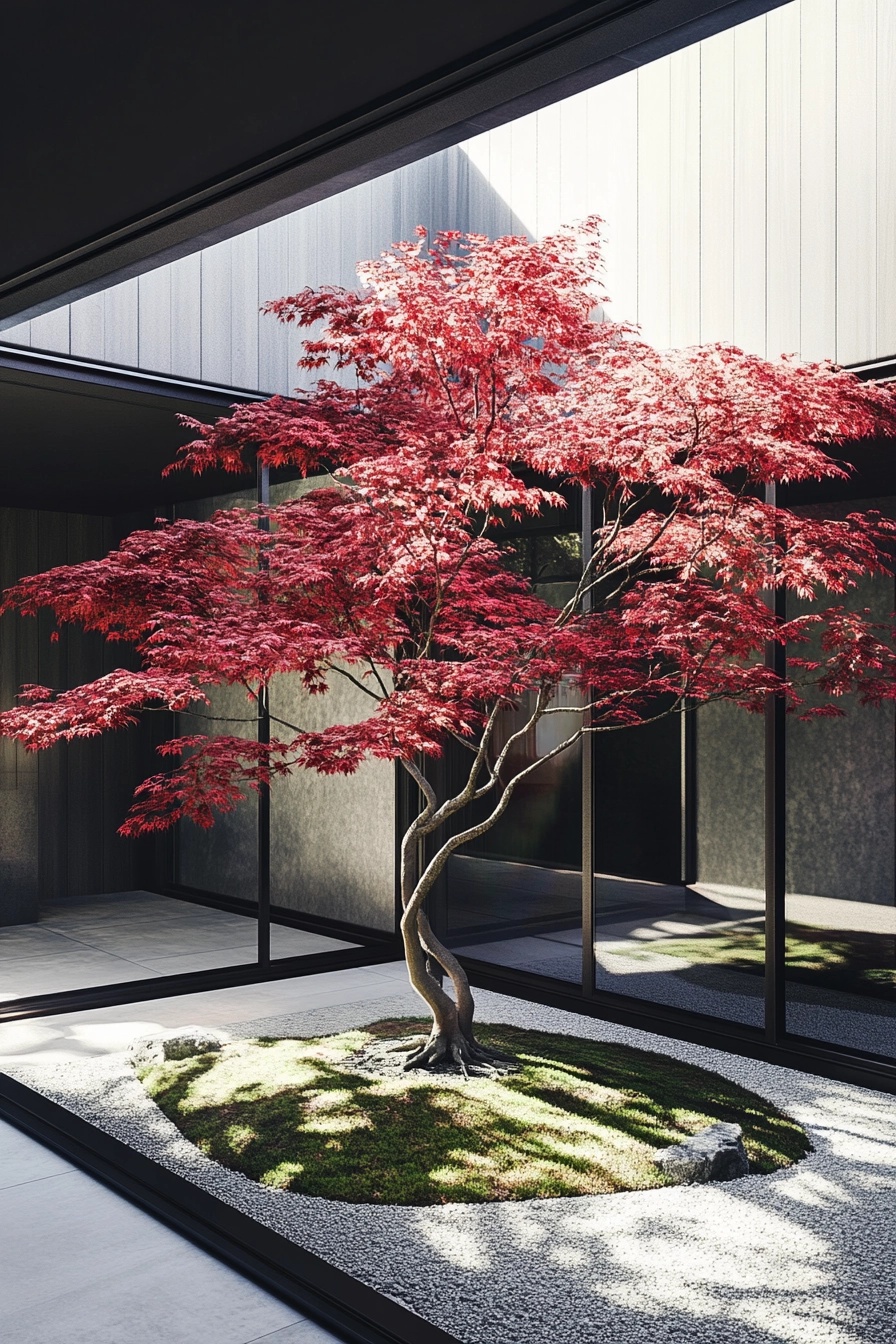
This stunning example showcases modern Japanese garden design. The stark contrast between the vibrant red maple and the clean lines of the surrounding architecture creates a powerful visual statement. The minimal ground cover emphasizes the tree’s sculptural beauty.
Japanese garden design isn’t stuck in the past; it translates beautifully into modern aesthetics too! If your home has clean lines and a contemporary feel, a modern Japanese courtyard garden can be the perfect extension. This style often embraces minimalism, focusing on strong forms and a limited palette. Just look at how incredible this single Japanese maple looks – its fiery red leaves and graceful shape are the undeniable stars against the sleek backdrop. Instead of intricate details, you might see more geometric shapes, smooth surfaces, and a very deliberate placement of just a few key elements like rocks or carefully chosen plants. It’s all about creating that Zen feeling with simplicity and sophistication.
4. Dramatic Flair: Dark Tones and Water Features

Using darker materials like black stepping stones, dark gravel, and stained wood for the pergola creates a sophisticated and slightly moody Japanese garden aesthetic. The contrast highlights the water feature and sparse green plantings effectively.
Who says Japanese gardens always have to be light and airy? Introducing darker tones can add a layer of drama and sophistication that’s truly captivating. I love how this design uses dark grey or black stepping stones and gravel, paired with the dark structure of the pergola. It creates such a striking contrast with the lighter gravel around the koi pond and the pops of green from the planting. A central water feature, like this peaceful pond, becomes even more of a focal point against the darker surroundings. This approach feels incredibly chic and modern, while still maintaining that essential connection to nature and tranquility inherent in Japanese garden design layouts.
5. Integrate Zen: Your Japanese Patio Oasis

This beautiful space seamlessly blends traditional Japanese garden elements like a koi pond and stone lanterns with a functional patio area. The pergola provides shade for seating, making it a true outdoor oasis that combines relaxation with Japanese aesthetics.
Why choose between a functional patio and a beautiful Japanese garden when you can have both? Integrating a seating area into your Japanese courtyard garden design creates the ultimate space for relaxation and contemplation. Imagine sipping tea while listening to the gentle sounds of a nearby water feature or watching koi swim lazily in a pond! This garden expertly combines gravel areas, stone lanterns, and lush plantings with a comfortable patio space shaded by a pergola. It feels like a natural extension of the living space, inviting you to step outside and truly immerse yourself in the serene atmosphere. This is one of my favorite Japanese backyard ideas – making beauty functional!
6. Intriguing Stepping Stone Path Design

Stepping stone paths are crucial in Japanese garden design layout. This example takes it to another level with large, dark stones seemingly floating over gravel or water, enhanced by subtle underlighting. It creates intrigue and guides the visitor beautifully through the space.
The journey is just as important as the destination in a Japanese garden, and the pathway plays a huge role in guiding that experience. Forget straight, boring concrete paths! Japanese garden design often uses stepping stones (tobi-ishi) laid out in thoughtful, sometimes asymmetrical patterns. This encourages mindfulness as you walk, forcing you to slow down and notice your surroundings. Look at this incredible example – the large, dark stones create such a strong visual line, and the way they seem to float over the gravel (or is it shallow water?) adds an element of magic, especially with the lighting. It makes you want to follow it and see where it leads. Designing an intriguing path is key to a captivating Japanese yard.
7. Tiny Water Feature, Big Tranquility
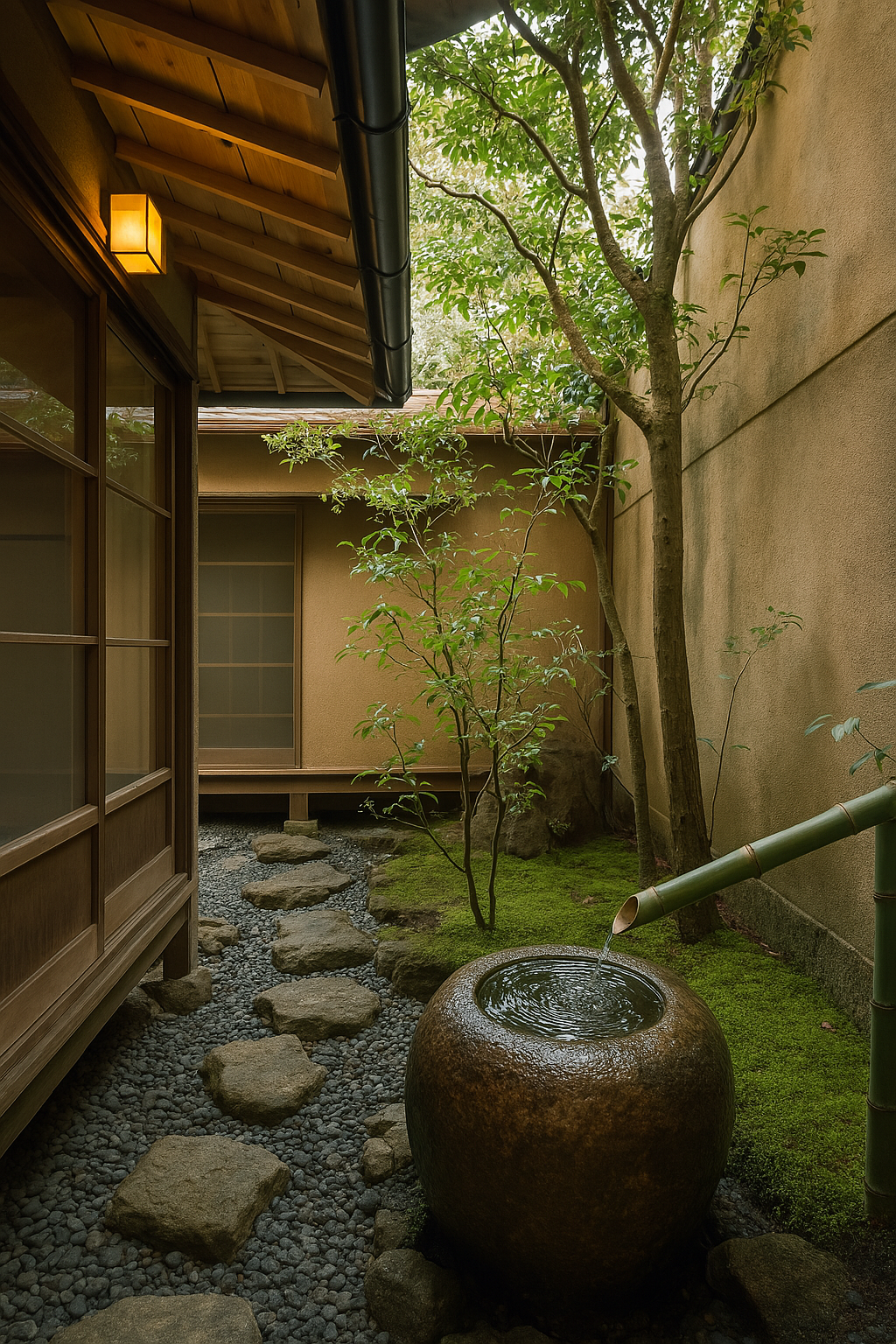
A simple stone basin (tsukubai) with a bamboo spout (kakei) is a classic element in Japanese gardens. Even this small feature adds the calming sound and sight of moving water, enhancing the serene atmosphere of this intimate courtyard space.
You don’t need a massive waterfall or pond to incorporate the essential element of water into your Japanese courtyard garden. Sometimes, the simplest features have the biggest impact. A traditional stone basin, known as a ‘tsukubai’, often placed low to the ground, is a perfect example. Originally used for ritual purification before tea ceremonies, its presence adds historical depth and a focal point for quiet contemplation. Paired with a bamboo spout (‘kakei’) trickling water, it introduces gentle movement and sound that instantly soothes the soul. Placed amongst moss and carefully selected stones, as seen here, it creates a beautifully authentic and peaceful corner in even the smallest Japanese inspired garden.
8. Traditional Path to Tranquility
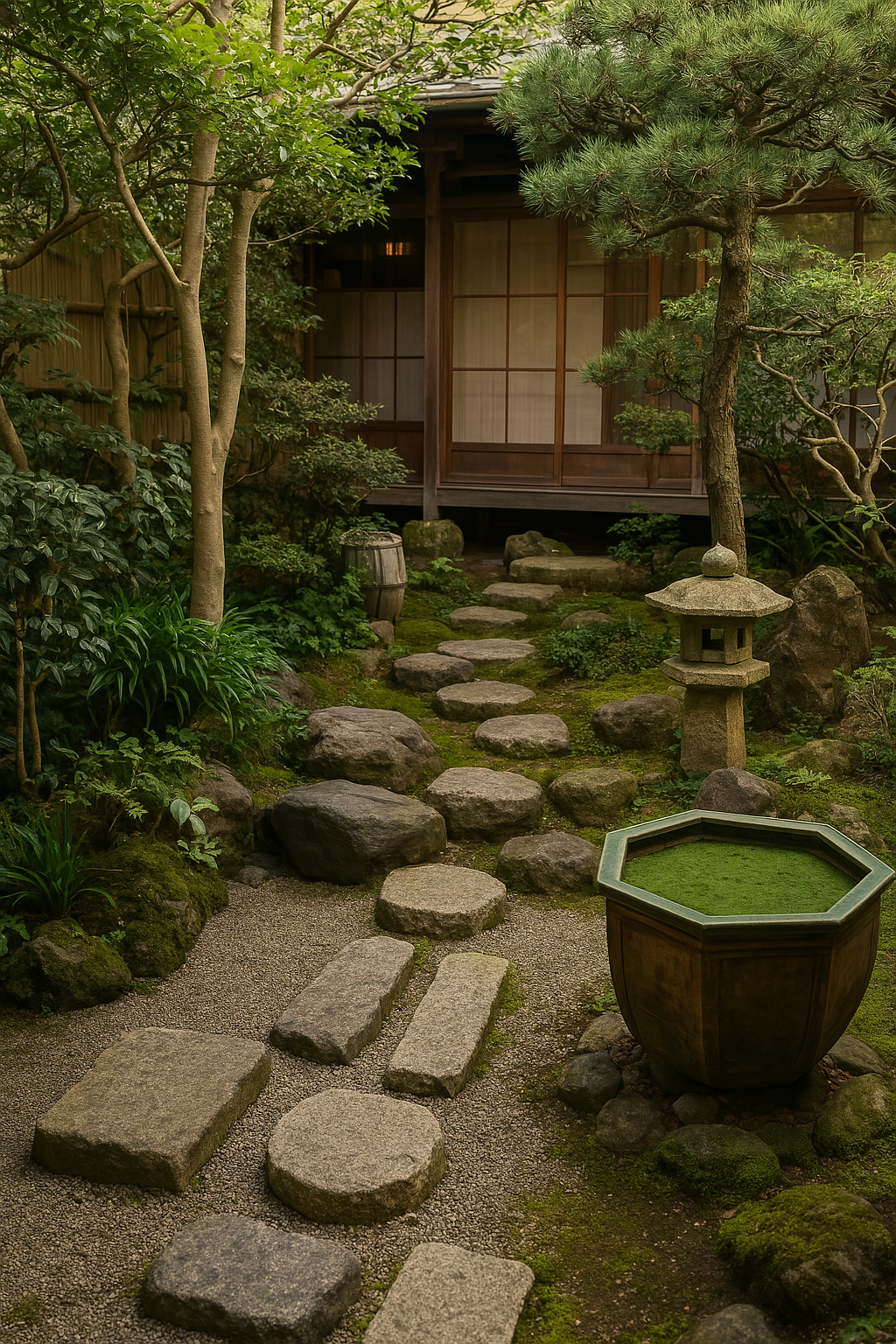
This path embodies classic Japanese garden design principles. Irregular stepping stones meander through lush moss, passing by weathered rocks and a traditional stone lantern, inviting slow, mindful steps towards the traditional building.
Let’s walk the path of tradition! This image perfectly captures the essence of a classic Japanese garden design layout. Notice how the stepping stones aren’t laid in a rigid, straight line? They meander, encouraging you to slow down, look around, and appreciate the details – the texture of the moss underfoot (well, beside the stones!), the aged patina of the rocks, the quiet dignity of the stone lantern (‘tōrō’). These lanterns weren’t just decorative; they historically illuminated paths and temple grounds. Including one adds an authentic touch and a sense of timelessness. Arranging these elements asymmetrically creates a natural, balanced feel that is deeply calming – a hallmark of beautiful Japanese gardens.
9. Lush Textures: Moss, Stone & Bloom
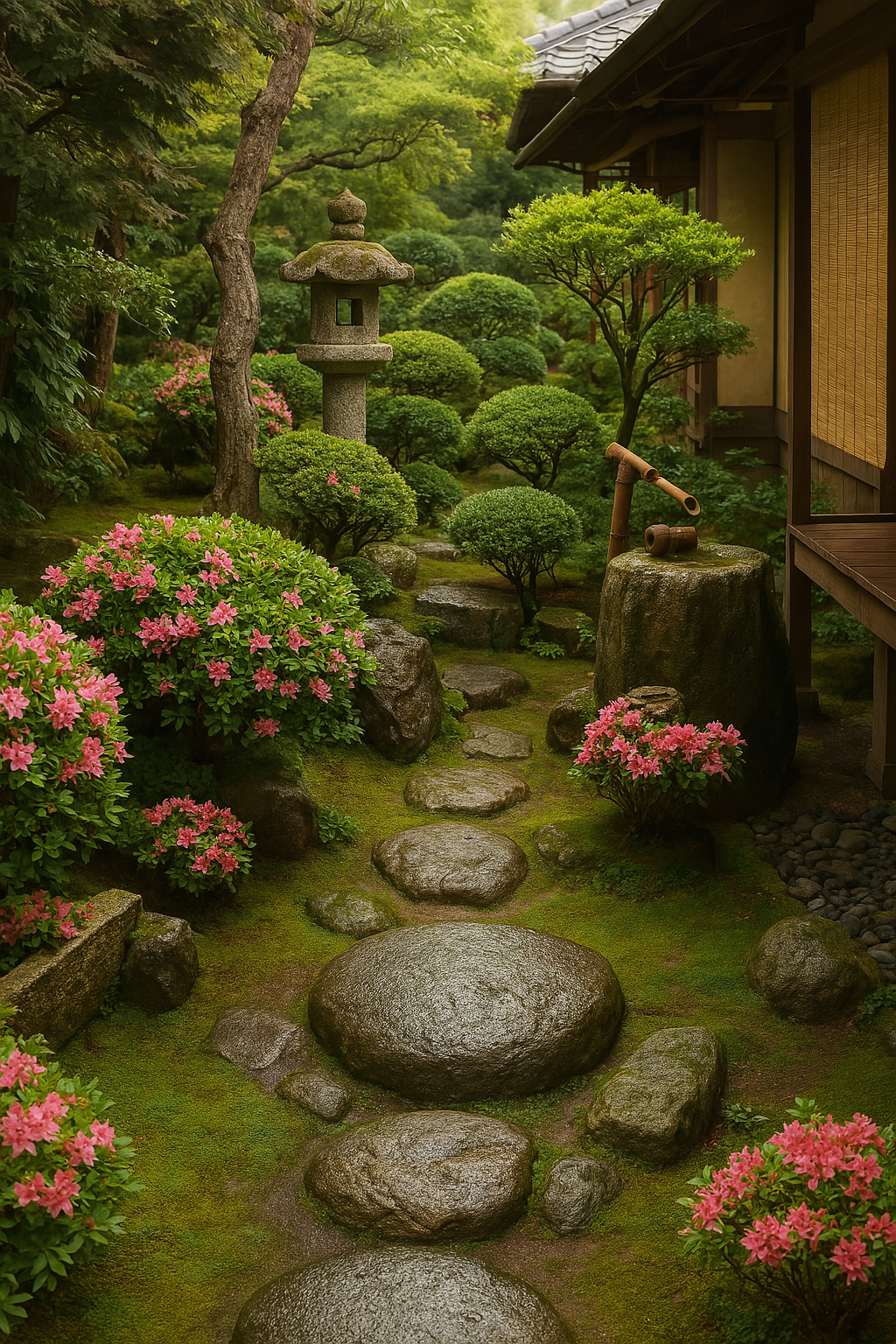
Japanese gardens excel at using texture. Here, the smoothness of wet stones contrasts beautifully with velvety moss, the delicate petals of azaleas, and the clipped forms of evergreen shrubs, creating a rich tapestry of textures.
Get ready to engage your senses! One of the things I adore most about the Japanese garden aesthetic is the masterful use of texture. It’s not just about visual appeal; it’s about how the garden feels. Look closely at this stunning scene: you have the smooth, often damp surface of the stepping stones, the incredibly soft, yielding look of the vibrant moss, the rougher texture of larger rocks, the delicate, papery feel of azalea blossoms, and the dense foliage of carefully pruned shrubs. Combining these different textures adds incredible depth and interest, making the garden feel alive and inviting. Even on a cloudy day, the interplay of textures, especially when damp from rainfall, makes the colours richer and the whole scene more immersive.
10. Simplicity is Serene: Minimalist Planting
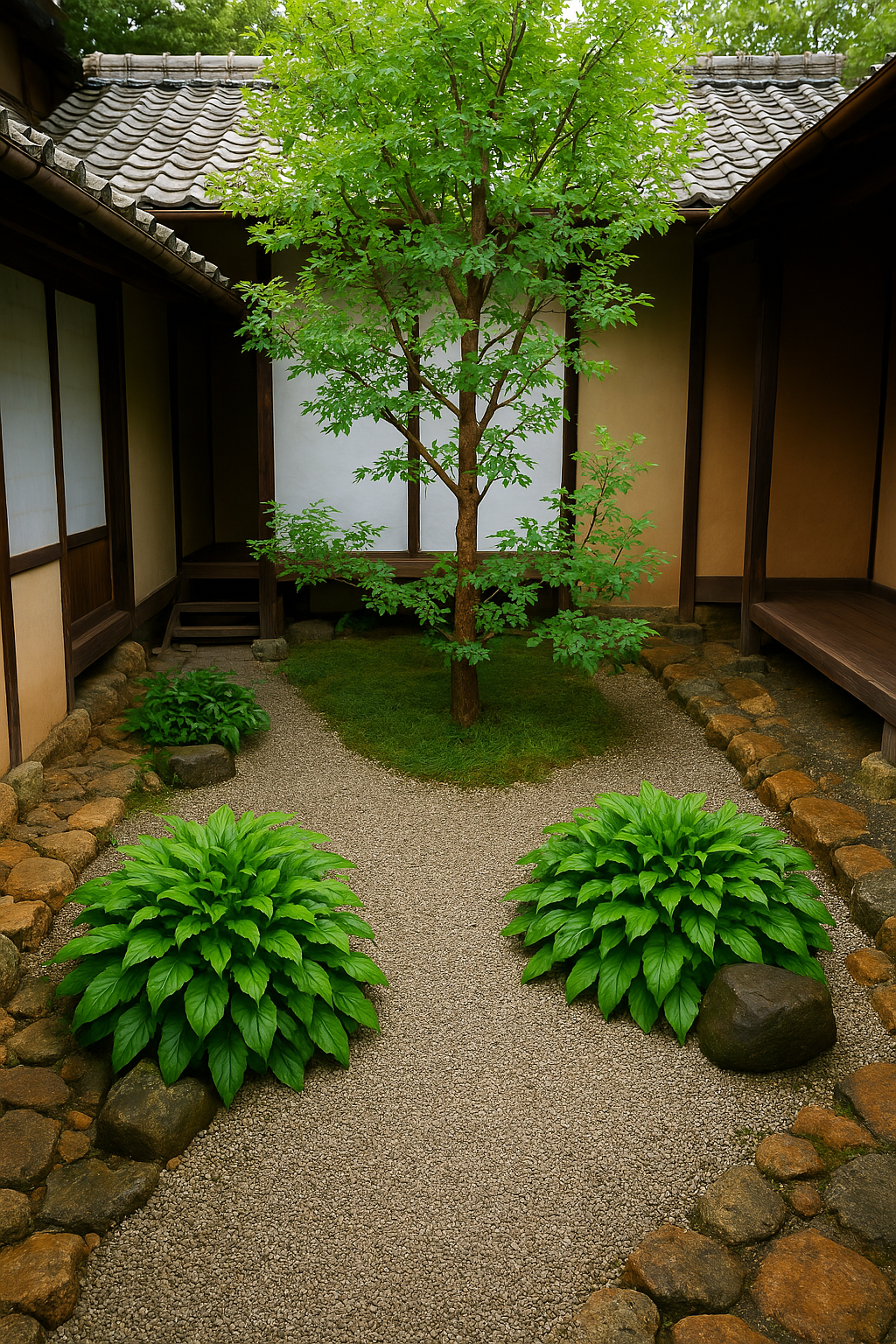
This design demonstrates the power of restraint in planting. A simple palette focusing on shades of green, with bold hosta forms and a single feature tree against clean gravel, creates a profoundly calm and uncluttered atmosphere.
Sometimes, the most peaceful spaces are the simplest ones. Japanese garden design often embraces the principle of ‘less is more,’ especially when it comes to planting. Instead of a riot of different colours and flower types, you’ll often find a focus on varying shades and textures of green, creating a unified and calming effect. This courtyard is a perfect example! The clean expanse of raked gravel provides negative space, allowing the key elements – the bold, architectural shapes of the hostas and the delicate structure of the central tree – to really shine. This minimalist approach doesn’t mean boring; it means thoughtful, intentional placement that promotes tranquility and allows each element to be fully appreciated. It’s a wonderful strategy for creating serenity in your Japanese yard.
11. A Tiny Corner of Zen
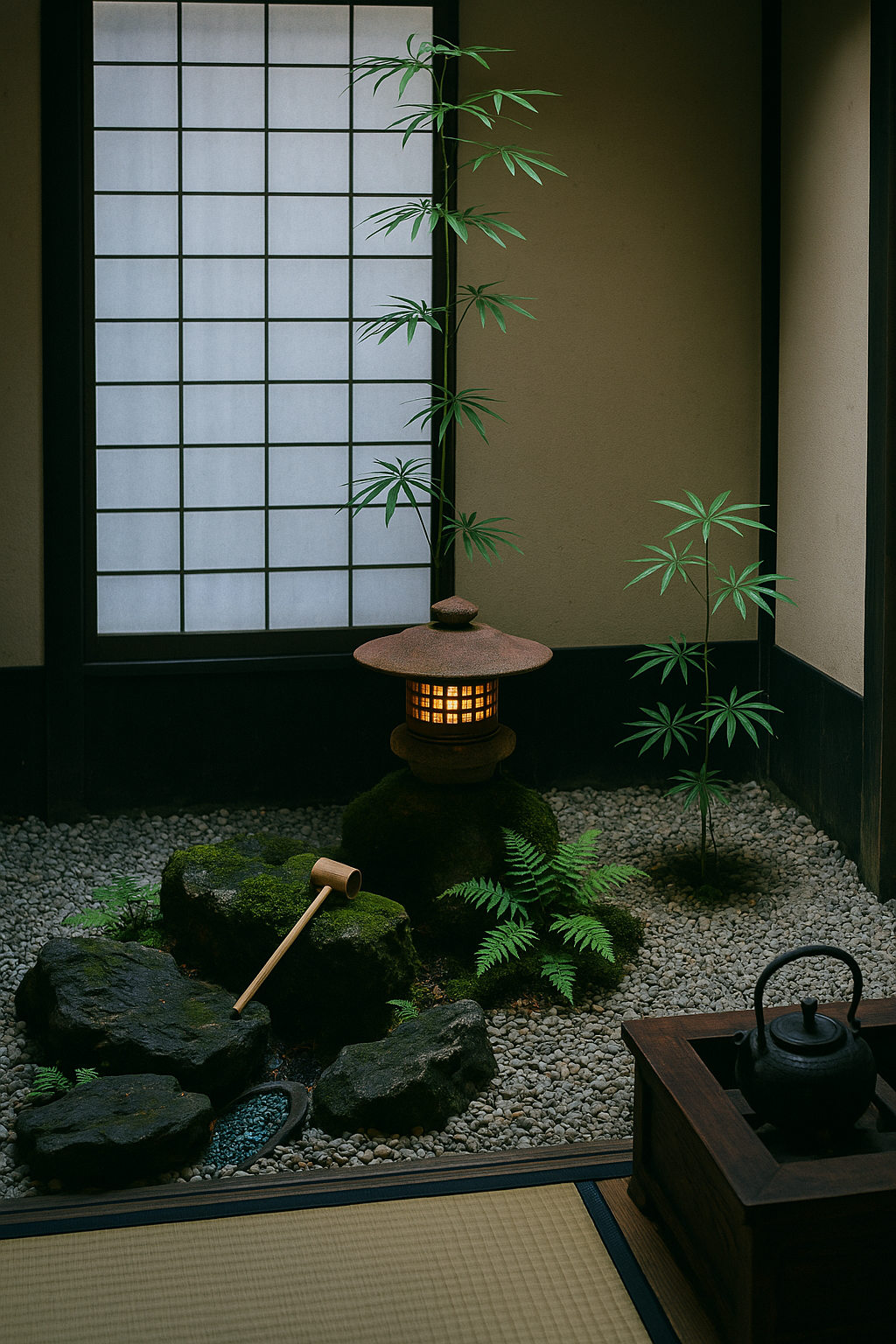
Even the smallest nook can be transformed into a Zen corner. This tiny setup uses gravel, mossy rocks, a miniature lantern, and slender bamboo plants to create a complete Japanese-inspired vignette, perfect for an entryway or covered patio.
Think you don’t have space for a Japanese garden? Think again! Even a tiny corner, perhaps by an entrance, on a balcony, or even indoors near a window, can become a miniature oasis of calm. Look how effectively this small space captures the Japanese garden aesthetic. A bed of fine gravel provides the base, contrasting with dark, moss-covered rocks. A small, glowing lantern adds warmth and focus, while a few carefully chosen plants, like the slender bamboo here, provide vertical interest without overwhelming the space. Adding a traditional element like the shoji screen in the background completes the picture. It’s proof that creating a Japanese inspired garden is more about thoughtful composition than sheer square footage.
12. Bringing the Outside In: Indoor Zen Garden View
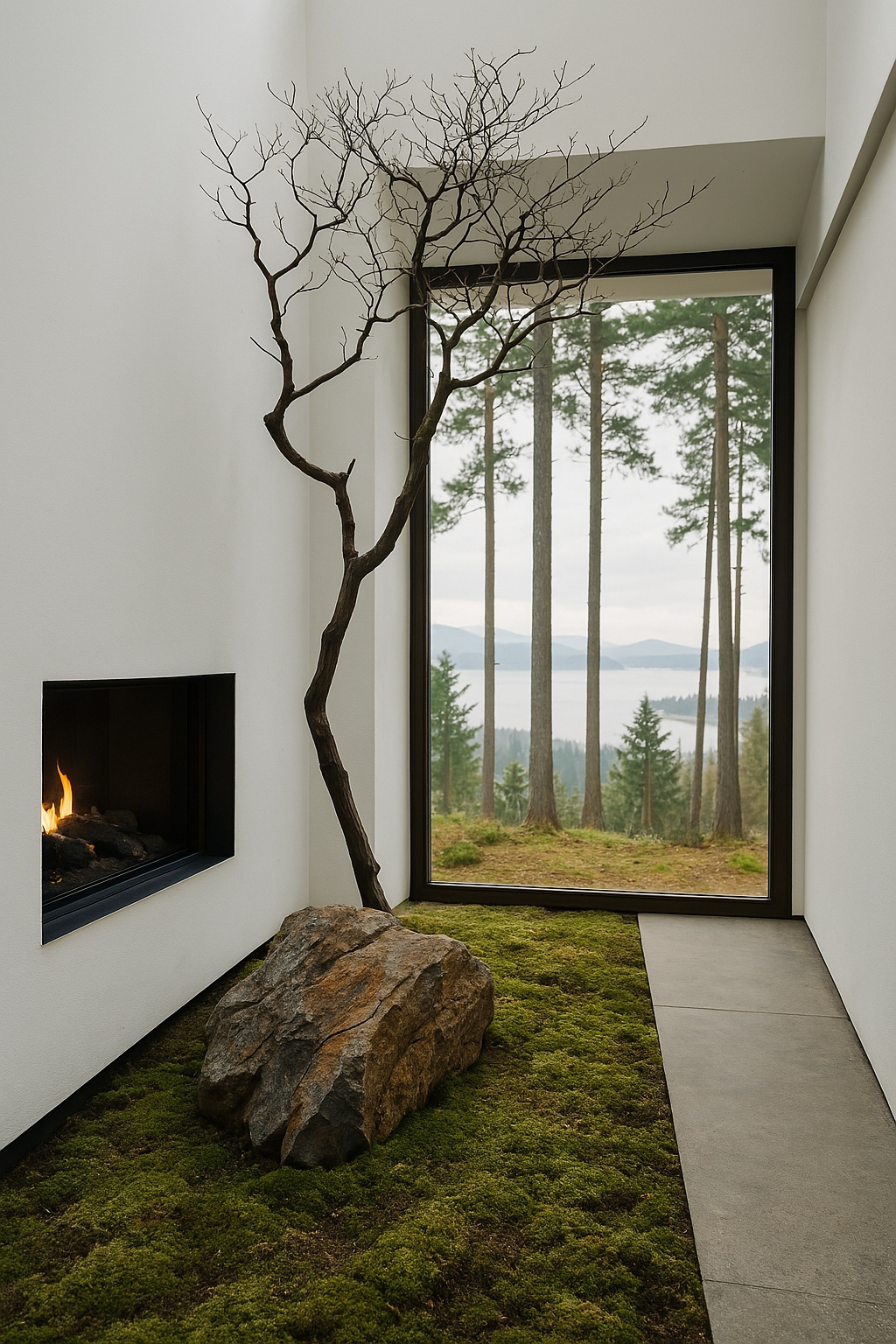
This breathtaking design incorporates an indoor garden element while masterfully using ‘borrowed scenery’ (shakkei). The minimalist indoor planting frames the magnificent natural view through the large window, making the outdoor landscape part of the interior design.
Let’s talk about blurring the lines between indoors and outdoors. This stunning space takes the concept of a Japanese courtyard garden and brings it right inside, creating an incredible feature. But notice what else is happening? The minimalist arrangement of moss, rock, and the sculptural tree acts as a frame for the breathtaking view outside the window. This is a classic Japanese garden design technique called ‘shakkei’, or borrowed scenery. By intentionally incorporating views of landscapes outside the garden’s borders – whether it’s distant hills, trees, or even the sky – the garden feels larger and more connected to the wider natural world. It’s a brilliant way to enhance the sense of peace and spaciousness, even when looking out from indoors.
FAQ
Q: What are the essential elements of a Japanese courtyard garden?
A: Key elements often include carefully placed rocks (ishi), water features (like basins or small ponds), lanterns (tōrō), perhaps a simple bamboo fence, and minimalist planting focusing on evergreen shrubs, moss, and feature trees like Japanese maples. The focus is on naturalism, symbolism, and creating a peaceful atmosphere even in a confined space.
Q: Can I create an authentic Japanese garden aesthetic in a small courtyard or backyard?
A: Absolutely! The principles of Japanese garden design, like asymmetry, symbolism, and borrowed scenery (even from the sky or surrounding walls), lend themselves beautifully to small spaces. Focus on fewer, well-chosen elements, careful scale, and creating depth through layering to achieve an authentic feel in your Japanese-inspired yard.
Q: What makes a Japanese garden design layout different, especially for a courtyard?
A: Unlike many Western gardens focused on symmetry or colorful flower beds, a Japanese garden layout emphasizes natural forms, balance (often asymmetrical), and creating a journey or miniature landscape. In a courtyard, the layout carefully guides the eye using paths, rocks, and plants to create a sense of peace and spaciousness within the limited area, often encouraging quiet contemplation.

